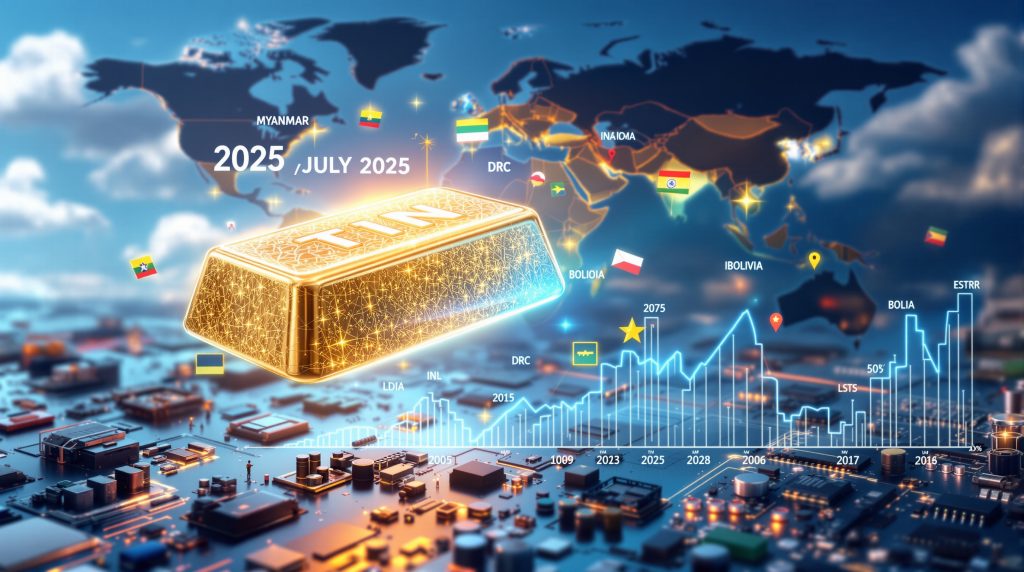What Is Driving Tin Price Volatility as Myanmar Resumes Exports?
The recent resumption of tin exports from Myanmar's Wa State has introduced significant volatility into global tin markets, creating both challenges and opportunities for investors. This development has highlighted the inherent fragility of tin supply chains while underscoring the metal's growing importance in the global technology landscape.
How Has Myanmar's Return to Tin Export Shaped Recent Price Movements?
In July 2025, Myanmar reinstated tin export operations from Wa State after a two-year halt, injecting supply representing approximately 10% of the global tin market. This significant supply addition had an immediate impact on pricing dynamics.
The resumption resulted in a 1.6% immediate drop in spot prices, lowering tin to US$32,775 per metric tonne as markets adjusted to the additional supply. This reaction demonstrates how sensitive the tin market is to even relatively modest changes in supply availability.
Despite this dip, the monthly average price for July 2025 climbed 3.3% over the previous month, reaching US$33,610 per tonne. This seemingly contradictory movement points to persistent upward price pressure beneath short-term volatility, suggesting strong fundamental demand remains intact.
The London Metal Exchange reported the steepest single-session decline in three months following Myanmar's export announcement, yet prices stabilized quickly as market participants assessed the longer-term implications of this supply development.
Why Is the Global Tin Market Considered Structurally Fragile?
Much of the world's tin output comes from politically unpredictable regions like Myanmar, Indonesia, and Bolivia, amplifying both price swings and supply risks. This geographic concentration in volatile jurisdictions creates inherent supply chain vulnerabilities that extend beyond normal commodity cycles.
The market's inherent "thinness" is highlighted by limited physical inventories and scarce swing capacity. Global tin stockpiles remain at historically low levels, creating a situation where even minor disruptions or resumptions in supply can trigger outsized price movements.
Industry analysts note that the tin sector is disproportionately reactive to localized political and operational risks given its supply concentration and minimal inventory buffers. This structural fragility persists even as technology-driven demand continues to accelerate.
Years of underinvestment in mineral exploration importance have constrained the pipeline of future tin projects, leaving the market vulnerable to supply shocks. Global tin exploration budgets remain below levels seen in the early 2010s, limiting the potential for significant new production capacity.
How Are Technological Shifts Fueling Tin Demand?
The technological landscape is rapidly evolving in ways that significantly increase tin consumption across multiple high-growth sectors. Despite short-term price volatility, these structural demand drivers provide strong long-term support for tin markets.
What Sectors Are Driving Tin Demand to 2030?
Demand for tin is projected to surge by 40% before 2030 according to the International Tin Association, owing to several converging factors:
- Accelerating transition to electric vehicles (EVs)
- Expansion of solar energy infrastructure
- Growth in advanced chip manufacturing for AI and computing
The Massachusetts Institute of Technology has identified tin as one of the most critical minerals & energy security technologies, emphasizing its essential role in the global energy transition. This designation recognizes tin's unique properties that make it irreplaceable in key applications.
Tin's Critical Applications and Unique Properties
Tin is deemed irreplaceable for high-temperature solder used in EV battery management, solar cell grids, and semiconductor packaging. Its combination of electrical conductivity, corrosion resistance, and compatibility with other metals creates a unique value proposition in these applications.
Each EV consumes approximately 3–5 kg of tin within crucial electronic systems, including battery management systems, charging infrastructure, and power electronics. As global EV adoption accelerates, this creates a substantial new demand segment for tin producers.
Tin's chemical stability and conductivity make substitution impractical in key energy and electronics contexts. While research continues into alternative materials, tin's physical and chemical properties provide advantages that are difficult to replicate with other elements.
Solar photovoltaic installations require tin for both cell manufacturing and grid connection systems. The expansion of renewable energy capacity globally creates additional demand pressure in a market already facing supply constraints.
Table: Tin Demand by Application (2025–2030 projection)
| Application | Tin Use (tons, est.) | Demand Trend to 2030 |
|---|---|---|
| Electric Vehicles | High (3–5kg/vehicle) | Rapid Rise |
| Solar/Photovoltaics | Significant | Accelerating |
| Semiconductors (AI chips) | Emerging | High Growth Rate |
| General Electronics | Steady | Stable |
What Are the Key Supply Chain Risks and Investment Considerations?
The tin market presents a complex risk landscape that extends beyond traditional supply-demand fundamentals. Understanding these nuanced factors is essential for effective investment strategies in this critical mineral sector.
How Do Governance and Geopolitics Amplify Supply Uncertainty?
Myanmar's Wa State operates with substantial local autonomy, often prioritizing local economic interests over national policy—resulting in unpredictable export cycles. The region's decision-making framework operates independently from central government control, creating a situation where export policies can change with minimal notice.
Indonesia faces offshore mining-related ecological resistance, while Bolivia must navigate complex community agreements that can disrupt production plans. Environmental concerns have increasingly impacted Indonesian operations, particularly those involving offshore dredging and alluvial mining methods.
These factors mean a single political or regulatory event can reshape global tin flows overnight. The two-year suspension of Myanmar exports demonstrated how quickly supply conditions can change, highlighting the need for diversified sourcing strategies.
The tin market's structural thinness means that even relatively small disruptions in key producing regions can have disproportionate impacts on global pricing and availability. This volatility creates both risks and opportunities for strategic investors.
How Are Stakeholders Responding to Geopolitical Pressures?
The United States and other Western economies are pursuing agreements with alternative suppliers, most notably the Democratic Republic of Congo (DRC), to counterbalance reliance on China and politically unstable regions. These mineral diplomacy initiatives aim to secure access to critical minerals for strategic industries.
Tech and defense sectors are adapting sourcing strategies to emphasize supply reliability and strategic partner alignment. Companies in these sectors increasingly view tin supply security as a competitive advantage rather than simply a procurement function.
The U.S. has negotiated critical mineral access agreements in the DRC to reduce dependence on Chinese-controlled supply chains and politically volatile regions like Myanmar. These agreements position the DRC as a strategic alternative for tin procurement, supported by improved regulatory frameworks and international development financing.
Can the DRC Fill the Tin Supply Gap?
As traditional tin suppliers face increasing challenges, the Democratic Republic of Congo is emerging as a potential solution to structural supply constraints. The country's geological potential and improving investment climate present compelling opportunities.
What Makes the DRC a Strategic Tin Producer?
The DRC is emerging as a high-potential alternative due to several converging factors:
- New, high-grade hard-rock tin discoveries (e.g., Alphamin Resources producing 17,324 tonnes in FY2024, +38% YOY)
- Favorable government policies and international investment, including U.S.-brokered critical mineral access
- Competitive production costs and efficient scaling in operations
The DRC's geological characteristics favor high-grade, hard-rock deposits that offer superior economics compared to declining-grade alluvial operations in Southeast Asia. These deposits typically allow for more predictable production scheduling and lower operating costs.
International development organizations have supported infrastructure improvements and community development initiatives that strengthen the social license for large-scale mining operations in the DRC. These programs help address historical challenges related to infrastructure and community relations.
Case Study: Transformative Production Growth
Alphamin Resources set industry benchmarks with a US$274 million EBITDA (+102% year-on-year), achieved plant recoveries of 75%, and forecasts further growth to 20,000 tonnes in FY2025. This operational success demonstrates the potential for efficient, large-scale tin production in the DRC.
The company's experience validates the DRC's geological potential while establishing operational benchmarks for subsequent developments in the region. Their success in navigating local operating conditions provides a valuable template for other developers.
Alphamin's fiscal year 2025 guidance of 20,000 tonnes positions the company as the world's highest-grade tin producer, with operations that deliver superior economics compared to traditional alluvial mining methods. Their cost position reinforces the competitive advantages available in the DRC's tin sector.
How Are Exploration and Project Development Evolving?
New entrants like Rome Resources are discovering broader mineralized zones beyond historic outlines, expanding DRC's resource base. Their exploration activities have identified significant tin mineralization outside previously defined geochemical soil anomalies, suggesting greater potential than initially anticipated.
Rome Resources operates three drilling rigs simultaneously to accelerate exploration progress and optimize geological understanding across multiple target areas. This aggressive approach aims to rapidly define resources and advance project development timelines.
Current metallurgical testing in Canada aims to assess processing flowsheets for polymetallic value extraction from their Monte Agoma prospect. These tests address a critical development milestone by establishing optimal recovery methods for tin, copper, and zinc mineralization in a single processing circuit.
What Differentiates Winning Tin Projects in Today's Market?
Success in the tin sector requires more than simply identifying resources. Leading developers employ sophisticated approaches to advance projects and create value across the development cycle.
What Methodologies Distinguish Leading Tin Developers?
High-impact projects combine several critical elements:
- Robust geological modeling and accelerated drilling schedules
- Investment in metallurgy to optimize multi-metal recovery from complex ores (e.g., integrated testing for tin, copper, zinc)
- Transparent permitting processes and local community integration programs
Rome Resources has engaged MSA Group to complete a Maiden Resource Estimate scheduled for September 2025, representing a major derisking milestone for their project. MSA Group's previous work on Alphamin Resources and other DRC projects provides relevant regional experience for resource modeling and mine planning activities.
Early drilling results indicate tin zones exceeding 40 meters in width within structurally favorable geological settings, suggesting significant scale potential for resource definition. These results point to substantial resource potential that could support large-scale mining operations.
Table: Summary of DRC Tin Project Financials
| Operation | FY2024 Output (tonnes) | YOY Output Growth | EBITDA (US$M) | Recovery Rate (%) |
|---|---|---|---|---|
| Alphamin Resources | 17,324 | +38% | $274 | 75 |
| Rome Resources | – (Maiden Resource Sept 2025) | – | – | – |
How Do Financial and Development Milestones Enhance Project Appeal?
Successful funding rounds (e.g., £8.2 million capital raise by Rome Resources in 2024) are funneled directly into resource expansion. This focused capital deployment maximizes value creation by accelerating critical project development activities.
Credible third-party resource validation (e.g., MSA Group) gears projects for rapid derisking and upscaled investor interest. Independent verification provides confidence to potential investors and partners, facilitating future funding rounds and strategic partnerships.
Rome Resources allocated approximately 49% of its recent capital raise proceeds to drilling and resource development activities. This prioritization demonstrates a clear focus on creating tangible value through resource definition and expansion.
How Are Investors Managing Jurisdictional and Market Risks?
Geographic diversification has become a central strategy for investors seeking exposure to the tin sector while managing the inherent risks of concentrated supply chains.
Why Is Geographic Diversification Crucial?
Persisting instability in legacy suppliers like Myanmar pushes investors towards jurisdictions with clearer policies, such as the DRC, adding risk resilience to portfolios. This shift represents a structural realignment of capital toward regions offering both geological potential and improved governance.
U.S. government and Gulf state funding for DRC infrastructure and regulatory reform further boosts investor confidence. These international investments help address historical challenges related to infrastructure, governance, and community development.
The DRC's repositioning benefits from improved permitting frameworks and enhanced artisanal mining integration programs. These reforms help address historical challenges related to informal mining activities and regulatory uncertainty.
Comparison Table: Key Tin Jurisdictions
| Jurisdiction | Geopolitical Risk | Supply Chain Security | Potential for Growth |
|---|---|---|---|
| Myanmar | High | Low | Short-term |
| Indonesia | Moderate | Variable | Stable |
| Bolivia | Medium | Moderate | Constrained |
| DRC | Improving | Increasing | High |
Frequently Asked Questions (FAQs) About Tin Prices and Supply
Why do tin prices remain volatile despite new exports?
The tin market has minimal buffers, so shifts in a single supplier—especially from a jurisdiction like Myanmar—trigger outsized short-term reactions even though core supply/demand remains tight. Global tin stockpiles remain at historically low levels, creating a situation where even minor disruptions can trigger significant price movements.
This volatility reflects the market's structural characteristics rather than changing fundamentals. The underlying supply-demand balance remains supportive of strong long-term pricing despite short-term fluctuations.
Is DRC likely to replace Myanmar as a long-term supplier?
While DRC's production is gaining momentum, full replacement depends on continued governance improvements and scaling of mining infrastructure. The country's geological potential is substantial, but realizing this potential requires ongoing investment in both mining operations and supporting infrastructure.
The United States-brokered access agreements provide additional investment security by establishing formal diplomatic frameworks for critical mineral procurement. These agreements reduce political risk premiums while creating preferential access conditions for Western technology companies requiring secure tin supplies.
How important is tin to new technologies?
Tin is essential to electrification and AI-driven sectors, with few substitutes for its particular industrial uses. The metal's unique combination of properties makes it irreplaceable in applications ranging from semiconductor packaging to battery management systems.
As advanced computing applications like artificial intelligence continue to expand, tin's role in semiconductor packaging becomes increasingly critical. These high-value applications drive demand growth while requiring consistent, high-quality supply sources.
What Should Investors Watch Next in the Tin Market?
The tin market presents a dynamic landscape with multiple potential catalysts that could reshape pricing and investment opportunities. Staying ahead of these developments requires monitoring several key factors.
What Near-Term Catalysts Could Reprice Tin?
Several upcoming developments could significantly impact tin markets:
- Scheduled resource upgrades (e.g., Rome Resources' Maiden Resource, September 2025)
- New international supply chain agreements or policy shifts favoring jurisdictional diversification
- Ongoing technology-driven demand acceleration, particularly in EV and AI markets
The September 2025 resource estimate from Rome Resources represents a significant potential catalyst, as it will provide concrete validation of the resource potential in their DRC project. A substantial maiden resource could trigger broader investor interest in the tin sector.
Technology-driven demand continues to accelerate, with electric vehicle production and semiconductor manufacturing creating new consumption patterns that support long-term market fundamentals. These structural demand drivers provide underlying support even during periods of price volatility.
What Are the Hallmarks of Investment-Grade Tin Opportunities?
Investors should look for several key characteristics when evaluating tin projects:
- Operational excellence in high-grade, scalable projects
- Strategic geographic placement in stable or improving jurisdictions
- Strong institutional backing or international financing
Projects combining these elements offer the most compelling risk-adjusted return potential in the current market environment. The alignment of geological potential, jurisdictional advantages, and operational capabilities creates sustainable competitive advantages.
The DRC's emergence as a preferred sourcing jurisdiction reflects broader supply chain diversification strategies implemented by technology companies and defense contractors. Unlike traditional mining jurisdictions focused primarily on production economics, the DRC offers strategic alignment with Western security interests while maintaining competitive production costs.
Conclusion: Staying Ahead in a Shifting Tin Market
While Myanmar's export reactivation creates immediate price changes, underlying supply constraints and rising demand for clean tech and semiconductors support a robust long-term outlook for tin prices under pressure as myanmar resumes exports. The market's response to Myanmar's return highlights the structural vulnerabilities rather than resolving them.
Regions like the DRC are reshaping the supply map, offering new venues for investment—but market participants must remain vigilant to trade war market impact and technological advances in production. The ongoing development of high-grade resources in the DRC provides a potential solution to long-term supply challenges.
The most attractive opportunities will come from projects blending resource quality, technical innovation, and geopolitical alignment. Strategic investors should view tin as a supply-constrained critical mineral with asymmetric upside potential driven by electrification demand growth and supply chain diversification imperatives.
Tin's unique properties and essential role in emerging technologies create a compelling long-term investment case despite short-term price volatility. Understanding the interplay between geopolitical factors, geological potential, and copper pricing insights is essential for navigating this dynamic market. For those looking to make informed investment decisions, studying the mineral deposit guide can provide valuable context about how tin deposits compare to other mineral resources.
Want to Capitalise on the Next Major Mineral Discovery?
Discovery Alert's proprietary Discovery IQ model instantly identifies significant ASX mineral discoveries, providing actionable insights for both short-term traders and long-term investors. Explore why historic discoveries can generate substantial returns by visiting the dedicated discoveries page and begin your 30-day free trial to stay ahead of the market.




